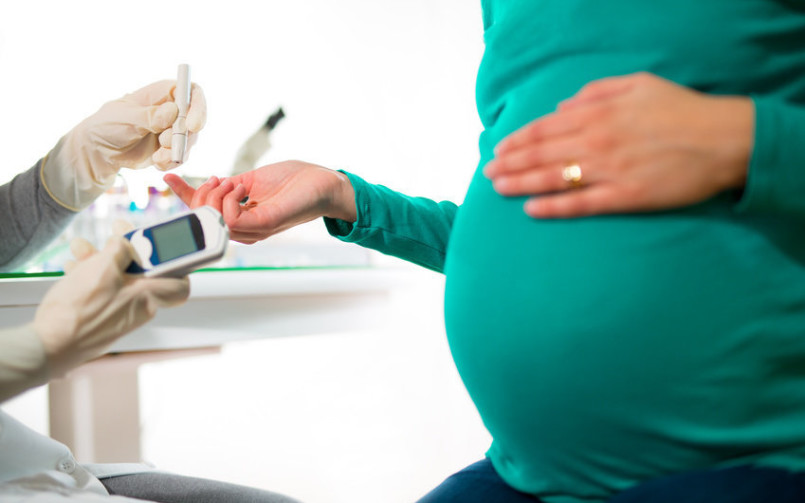
Diabetes in Pregnancy
Diabetes in Pregnancy
Gestational diabetes is high blood sugar that develops during pregnancy and usually disappears after giving birth.
It can occur at any stage of pregnancy, but is more common in the second half.
It occurs if your body cannot produce enough insulin – a hormone that helps control blood sugar levels – to meet the extra needs in pregnancy.
Gestational diabetes can cause problems for you and your baby during and after birth. But the risk of these problems happening can be reduced if it’s detected and well managed.
Who’s at risk of gestational diabetes
Any woman can develop gestational diabetes during pregnancy, but you’re at an increased risk if:
- your body mass index (BMI)is above 30 – use the healthy weight calculator to work out your BMI
- you previously had a baby who weighed 4.5kg (10lbs) or more at birth
- you had gestational diabetes in a previous pregnancy
- one of your parents or siblings has diabetes
- your family origins are south Asian, Chinese, African-Caribbean or Middle Eastern
If any of these apply to you, you should be offered screening for gestational diabetes during your pregnancy.
How gestational diabetes can affect your pregnancy
Most women with gestational diabetes have otherwise normal pregnancies with healthy babies.
However, gestational diabetes can cause problems such as:
- your baby growing larger than usual – this may lead to difficulties during the delivery and increases the likelihood of needing induced labouror a caesarean section
- polyhydramnios– too much amniotic fluid (the fluid that surrounds the baby) in the womb, which can cause premature labour or problems at delivery
- premature birth– giving birth before the 37th week of pregnancy
- pre-eclampsia– a condition that causes high blood pressure during pregnancy and can lead to pregnancy complications if not treated
- your baby developing low blood sugar or yellowing of the skin and eyes (jaundice) after he or she is born, which may require treatment in hospital
- the loss of your baby (stillbirth)– though this is rare
Having gestational diabetes also means you’re at an increased risk of developing type 2 diabetes in the future.
Screening for gestational diabetes
During your first antenatal appointment at around weeks 8 to 12 of your pregnancy, your midwife or doctor will ask you some questions to determine whether you’re at an increased risk of gestational diabetes.
If you have one or more risk factors for gestational diabetes – see ‘Who’s at risk’ – you should be offered a screening test.
The screening test used is called an oral glucose tolerance test (OGTT), which takes about two hours.
It involves having a blood test taken in the morning when you’ve had nothing to eat or drink overnight (you can usually drink water, but check with the hospital if you’re unsure). You’re then given a glucose drink.
After resting for two hours, another blood sample is taken to see how your body is dealing with the glucose.
The OGTT is done when you’re between 24 and 28 weeks pregnant. If you’ve had gestational diabetes before, you’ll be offered an OGTT earlier in pregnancy soon after your booking visit, and another OGTT at 24 to 28 weeks if the first test is normal.
Treatments for gestational diabetes
In women with gestational diabetes, the chances of having problems with the pregnancy can be reduced by controlling blood sugar levels.
You’ll be given a blood sugar testing kit so you can monitor the effects of treatment.
Blood sugar levels can be reduced by changes in diet and exercise. But the majority of women will need medication as well if changes in diet and exercise don’t reduce blood sugar enough. This may be tablets or insulin injections.
You’ll also be more closely monitored during your pregnancy and birth to check for any potential problems.
If you have gestational diabetes, it’s best to give birth before 41 weeks. Induction of labour or a caesarean section may be recommended if labour doesn’t start naturally by this time.
Earlier delivery may be recommended if there are concerns about your or your baby’s health or if your blood sugar levels haven’t been well controlled.
Long-term effects of gestational diabetes
Gestational diabetes normally goes away after birth. But women who’ve had it are more likely to develop:
- gestational diabetes again in future pregnancies
- type 2 diabetes– a lifelong type of diabetes
You should have a blood test to check for diabetes 6 to 13 weeks after giving birth, and every year thereafter if the result is normal.
See your GP if you develop symptoms of high blood sugar, such as increased thirst, needing to pee more often than usual, and a dry mouth – don’t wait until your next test.
You should have the tests even if you feel well, as many people with diabetes don’t have any symptoms.
You’ll also be advised about things you can do to reduce your risk of developing diabetes, such as maintaining a healthy weight, eating a balanced diet and exercising regularly.
Some research has suggested that babies of mothers who had gestational diabetes may be more likely to develop diabetes or become obese later in life if sugar is not controlled during pregnancy.